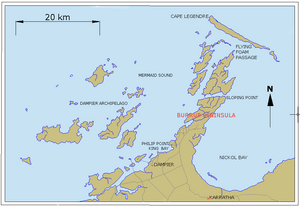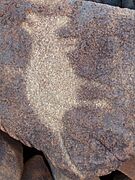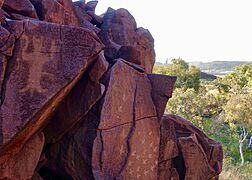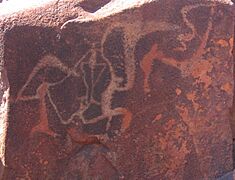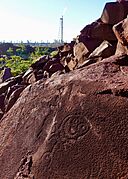Burrup Peninsula facts for kids
The Burrup Peninsula, once known as Dampier Island, is a special place in the Pilbara region of Western Australia. It was originally an island, part of the Dampier Archipelago, but is now connected to the mainland by a road. This area, including the nearby islands, is also known as Murujuga. It is home to the town of Dampier and the Murujuga National Park. Murujuga is famous for having the world's largest collection of ancient rock art, called petroglyphs, some of which are up to 40,000 years old! People are working hard to protect this amazing art, as industrial growth in the area has caused some damage and raised concerns about pollution.
The region is sometimes confused with the Dampier Peninsula, about 800 kilometers to the north-east.
| UNESCO World Heritage Site | |
|---|---|
| Criteria | i, iii, v |
| Inscription | 2025 (49th Session) |
| Extensions | 99.881 ha |
Contents
Amazing Ancient Rock Art
Most of the Murujuga rock art is carved into very old igneous rocks, which are about 2.7 billion years old. The artists created the art by carefully scratching away the reddish-brown outer layer of the rock. This revealed a lighter, weathered clay layer underneath. The hard rock below is dark grey-green.
- Examples of rock art at Murujuga
A Rich History and Special Names
Who Are the Traditional Owners?
The original people who have cared for Murujuga for thousands of years are an Aboriginal nation called the Yaburara (Jaburara) people. In their language, murujuga means "hip bone sticking out." After a difficult event in 1869, five clans took over the care of this land. These include the Yaburara, Ngarluma, Mardudhunera, Yindjibarndi, and Wong-Goo-Tt-Oo peoples. They are the traditional custodians of Murujuga.
From Island to Peninsula
The area was first named Dampier Island after an English explorer, William Dampier (1651–1715). At that time, it was an island about 3 kilometers off the coast. In 1963, it became an artificial peninsula when a causeway was built to connect it to the mainland for roads and a railway. In 1979, Dampier Peninsula was renamed Burrup Peninsula. This new name came from Mount Burrup, the highest point on the island, which was named after Henry Burrup.
Protecting This Special Place
The Burrup Peninsula is a very special place because it holds the world's largest and most important collection of petroglyphs. Some of these ancient carvings are more than 45,000 years old. There are also many standing stones, and over a million rock art images. Many of these images show animals that are now extinct, like the thylacine (Tasmanian tiger). The Dampier Rock Art Precinct covers the whole area, and Murujuga National Park is within the Burrup.
Balancing Industry and Heritage
For many years, there have been discussions about how to protect this important cultural area while also allowing for industrial growth. People have been calling for the protection of Murujuga since 1969. Many groups, including the International Federation of Rock Art Organizations and the National Trust of Australia, have worked to save the remaining art. The site has been listed on the World Monuments Fund's watch list several times, highlighting its endangered status.
Sadly, some rock art has been lost due to industrial development. Between 1963 and 2006, a number of rock art sites were destroyed to make way for new facilities. For example, hundreds of petroglyphs were cleared for a gas facility in 2006-2007. It is estimated that thousands of carvings were lost during the construction of various industrial projects.
In 1996, a plan was made to divide the region into two main areas: one for conservation, heritage, and recreation, and another for industry. This plan aimed to balance the different needs of the area.
The traditional owners, including the Ngarluma and Yindjibarndi people, have been involved in discussions about land use. They have worked to ensure their heritage is recognized and protected. In 2007, the Australian Government officially listed 90% of the remaining rock art areas of the Dampier Archipelago on the National Heritage List. This was a big step towards protecting the site. In 2025, Murujuga was also recognized as a World Heritage Site by UNESCO, which means it's considered important for all of humanity.
Even with these protections, discussions continue about new industrial projects, such as the Scarborough gas project. This project, which includes a pipeline and an expansion of a processing facility, received environmental approval. Production is planned for 2026. Research is ongoing to understand if increased emissions from such projects could affect the ancient rock art. Traditional owners continue to voice their concerns about protecting their cultural heritage.
What is Pollution's Impact?
Besides physical damage from building new facilities, the Murujuga rock art has also been affected by industrial pollution. Acidic dust from industrial activities can mix with water and create acids. These acids can slowly damage the rock's surface, causing the ancient carvings to break apart. Scientists believe that reducing pollution is very important to keep this precious rock art safe for future generations.
Discoveries Under the Sea
On July 1, 2020, scientists announced an exciting discovery: Australia's first ancient Aboriginal underwater archaeological sites! These sites were found in two locations off the Burrup Peninsula. At Cape Bruguieres, 269 ancient objects were found. Another site at Flying Foam Passage, off Dampier, revealed an 8,500-year-old underwater freshwater spring.
These discoveries include hundreds of stone tools and grinding stones. They provide amazing evidence of how people lived thousands of years ago, before sea levels rose after the last ice age (between 7,000 and 18,000 years ago). The Australian Archaeological Association called this research "highly significant."
This important work was the result of four years of effort by a team of archaeologists, rock art experts, geomorphologists, geologists, pilots, and scientific divers. They worked together with the Murujuga Aboriginal Corporation on a project called "Deep History of Sea Country."
The underwater sites are now protected under the Western Australian Aboriginal Heritage List.
Explore the Ngajarli Trail
The Ngajarli Trail was completed in August 2020, after the Murujuga National Park was temporarily closed for its construction. Traditional owners worked with the government to create a 700-meter long universal boardwalk. Along the trail, there are interpretative signs that help visitors learn about the cultural importance of the site. The Murujuga Aboriginal Corporation hopes to make the park even better for visitors and help everyone appreciate its deep cultural meaning.
See also
 In Spanish: Murujuga para niños
In Spanish: Murujuga para niños
- Visual arts of Australia
- Prehistory of Australia
Images for kids


